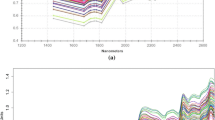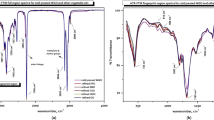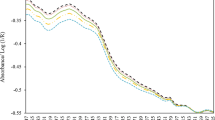Abstract
Diffuse reflectance Fourier transform infrared spectroscopy was investigated as a method for rice surface lipid determination. Long- and medium-grain rice was milled at four degrees of milling to obtain samples with various levels of residual bran, and total lipids were determined by solvent extraction. Fourier transform infrared spectra were collected between 4000 and 400 cm−1. Weighted regression analysis identified changes in surface chemical functional groups with bran removal. Groups typical of lipids increased with bran content whereas those typical of carbohydrates and protein decreased. Partial least squares (PLS) regression analysis showed a high degree of correlation between the spectra in the 4000–400 cm−1 range and extracted lipids of long-grain rice (R 2=0.96) and medium-grain rice (R 2=0.96); a high degree of correlation was also observed when long- and medium-grain rice data were combined (R 2=0.96). There was a high positive correlation between the spectra and extracted lipids in the 1300–1000 cm−1 range for the long-grain rice (R 2=0.98), medium-grain rice (R 2=0.98), and combined long-/medium-grain rice data (R 2=0.94). PLS selected spectral regions that correlated positively with functional groups of lipid/lipid oxidation products and negatively with functional groups of protein and carbohydrates.
Similar content being viewed by others
References
Hogan, J.T., and H.J. Deobald, Note on Method of Determining the Degree of Milling of Whole Milled Rice, Cereal Chem. 38:291–293, (1961).
Sun, H., and T.J. Siebenmorgen, Milling Characteristics of Various Rough Rice Kernel Thickness Fractions —Ibid. 70:727–733 (1993).
Chen, H., and T.J. Siebenmorgen, Effect of Rice Kernel Thickness on Degree of Milling and Associated Optical Measurements. —Ibid. 74:821–825 (1997).
Chen, H., B.P. Marks, and T.J. Siebenmorgen, Quantifying Surface Lipid Content of Milled Rice via Visible/Near Infrared Spectroscopy, —Ibid. 74:826–831 (1997).
McClure, W.F., Near Infrared Spectroscopy, in Spectroscopic Techniques for Food Analysis, edited by R.H. Wilson, VCH Publishers, New York, 1994, pp. 13–14.
Wilson, R.H., and B.J. Goodfellow, Mid Infrared Spectroscopy, in Spectroscopic Techniques for Food Analysis, edited by R.H. Wilson, VCH Publishers, New York, 1994, pp. 59–60.
Guillen, M.D., and N. Cabo, Characterization of Edible Oils and Lard by Fourier Transform Infrared Spectroscopy—Relationship Between Composition and Frequency of Concrete Bands in the Fingerprint Region, J. Am. Oil Chem. Soc. 74:1281–1286 (1997).
The Unscrambler 7.5 User's Guide (Addendum), Computer-Aided Modelling A/S, Trondheim, Norway, 1999.
Silverstein, R.M., G.C. Bassler, and T.C. Morrill, Infrared Spectrometry, in Spectrometric Identification of Organic Compounds, John Wiley & Sons, New York, 1991, pp. 102–132.
Author information
Authors and Affiliations
Corresponding author
About this article
Cite this article
Gangidi, R.R., Proctor, A. & Meullenet, JF. Milled rice surface lipid measurement by diffuse reflectance fourier transform infrared spectroscopy (DRIFTS). J Amer Oil Chem Soc 79, 7–12 (2002). https://doi.org/10.1007/s11746-002-0427-4
Received:
Accepted:
Issue Date:
DOI: https://doi.org/10.1007/s11746-002-0427-4




